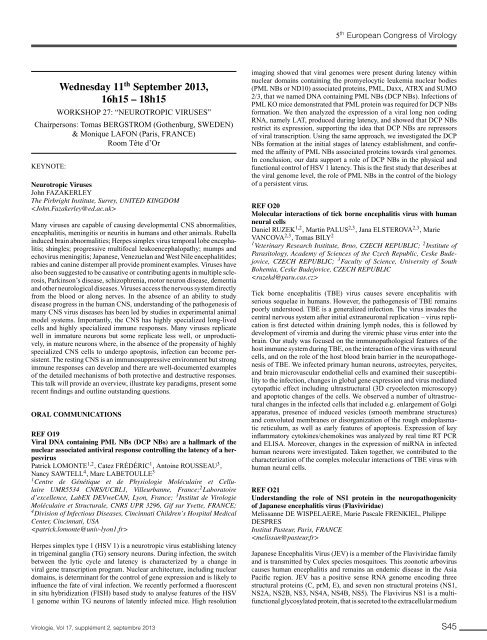rologie i - European Congress of Virology
rologie i - European Congress of Virology
rologie i - European Congress of Virology
Create successful ePaper yourself
Turn your PDF publications into a flip-book with our unique Google optimized e-Paper software.
5 th <strong>European</strong> <strong>Congress</strong> <strong>of</strong> <strong>Virology</strong>Wednesday 11 th September 2013,16h15 – 18h15WORKSHOP 27: “NEUROTROPIC VIRUSES”Chairpersons: Tomas BERGSTROM (Gothenburg, SWEDEN)& Monique LAFON (Paris, FRANCE)Room Tête d’OrKEYNOTE:Neurotropic VirusesJohn FAZAKERLEYThe Pirbright Institute, Surrey, UNITED KINGDOMMany viruses are capable <strong>of</strong> causing developmental CNS abnormalities,encephalitis, meningitis or neuritis in humans and other animals. Rubellainduced brain abnormalities; Herpes simplex virus temporal lobe encephalitis;shingles; progressive multifocal leukoencephalopathy; mumps andechovirus meningitis; Japanese, Venezuelan and West Nile encephalitides;rabies and canine distemper all provide prominent examples. Viruses havealso been suggested to be causative or contributing agents in multiple sclerosis,Parkinson’s disease, schizophrenia, motor neuron disease, dementiaand other neurological diseases. Viruses access the nervous system directlyfrom the blood or along nerves. In the absence <strong>of</strong> an ability to studydisease progress in the human CNS, understanding <strong>of</strong> the pathogenesis <strong>of</strong>many CNS virus diseases has been led by studies in experimental animalmodel systems. Importantly, the CNS has highly specialized long-livedcells and highly specialized immune responses. Many viruses replicatewell in immature neurons but some replicate less well, or unproductively,in mature neurons where, in the absence <strong>of</strong> the propensity <strong>of</strong> highlyspecialized CNS cells to undergo apoptosis, infection can become persistent.The resting CNS is an immunosuppressive environment but strongimmune responses can develop and there are well-documented examples<strong>of</strong> the detailed mechanisms <strong>of</strong> both protective and destructive responses.This talk will provide an overview, illustrate key paradigms, present somerecent findings and outline outstanding questions.ORAL COMMUNICATIONSREF O19Viral DNA containing PML NBs (DCP NBs) are a hallmark <strong>of</strong> thenuclear associated antiviral response controlling the latency <strong>of</strong> a herpesvirusPatrick LOMONTE 1,2 , Catez FRÉDÉRIC 1 , Antoine ROUSSEAU 3 ,Nancy SAWTELL 4 , Marc LABETOULLE 31 Centre de Génétique et de Physiologie Moléculaire et CellulaireUMR5534 CNRS/UCBL1, Villeurbanne, France; 2 Laboratoired’excellence, LabEX DEVweCAN, Lyon, France; 3 Institut de Vi<strong>rologie</strong>Moléculaire et Structurale, CNRS UPR 3296, Gif sur Yvette, FRANCE;4 Division <strong>of</strong> Infectious Diseases, Cincinnati Children’s Hospital MedicalCenter, Cincinnati, USAHerpes simplex type 1 (HSV 1) is a neurotropic virus establishing latencyin trigeminal ganglia (TG) sensory neurons. During infection, the switchbetween the lytic cycle and latency is characterized by a change inviral gene transcription program. Nuclear architecture, including nucleardomains, is determinant for the control <strong>of</strong> gene expression and is likely toinfluence the fate <strong>of</strong> viral infection. We recently performed a fluorescentin situ hybridization (FISH) based study to analyse features <strong>of</strong> the HSV1 genome within TG neurons <strong>of</strong> latently infected mice. High resolutionimaging showed that viral genomes were present during latency withinnuclear domains containing the promyelocytic leukemia nuclear bodies(PML NBs or ND10) associated proteins, PML, Daxx, ATRX and SUMO2/3, that we named DNA containing PML NBs (DCP NBs). Infections <strong>of</strong>PML KO mice demonstrated that PML protein was required for DCP NBsformation. We then analyzed the expression <strong>of</strong> a viral long non codingRNA, namely LAT, produced during latency, and showed that DCP NBsrestrict its expression, supporting the idea that DCP NBs are repressors<strong>of</strong> viral transcription. Using the same approach, we investigated the DCPNBs formation at the initial stages <strong>of</strong> latency establishment, and confirmedthe affinity <strong>of</strong> PML NBs associated proteins towards viral genomes.In conclusion, our data support a role <strong>of</strong> DCP NBs in the physical andfunctional control <strong>of</strong> HSV 1 latency. This is the first study that describes atthe viral genome level, the role <strong>of</strong> PML NBs in the control <strong>of</strong> the biology<strong>of</strong> a persistent virus.REF O20Molecular interactions <strong>of</strong> tick borne encephalitis virus with humanneural cellsDaniel RUZEK 1,2 , Martin PALUS 2,3 , Jana ELSTEROVA 2,3 , MarieVANCOVA 2,3 , Tomas BILY 21 Veterinary Research Institute, Brno, CZECH REPUBLIC; 2 Institute <strong>of</strong>Parasitology, Academy <strong>of</strong> Sciences <strong>of</strong> the Czech Republic, Ceske Budejovice,CZECH REPUBLIC; 3 Faculty <strong>of</strong> Science, University <strong>of</strong> SouthBohemia, Ceske Budejovice, CZECH REPUBLICTick borne encephalitis (TBE) virus causes severe encephalitis withserious sequelae in humans. However, the pathogenesis <strong>of</strong> TBE remainspoorly understood. TBE is a generalized infection. The virus invades thecentral nervous system after initial extraneuronal replication – virus replicationis first detected within draining lymph nodes, this is followed bydevelopment <strong>of</strong> viremia and during the viremic phase virus enter into thebrain. Our study was focused on the immunopathological features <strong>of</strong> thehost immune system during TBE, on the interaction <strong>of</strong> the virus with neuralcells, and on the role <strong>of</strong> the host blood brain barrier in the neuropathogenesis<strong>of</strong> TBE. We infected primary human neurons, astrocytes, perycites,and brain microvascular endothelial cells and examined their susceptibilityto the infection, changes in global gene expression and virus mediatedcytopathic effect including ultrastructural (3D cryoelecton microscopy)and apoptotic changes <strong>of</strong> the cells. We observed a number <strong>of</strong> ultrastructuralchanges in the infected cells that included e.g. enlargement <strong>of</strong> Golgiapparatus, presence <strong>of</strong> induced vesicles (smooth membrane structures)and convoluted membranes or disorganization <strong>of</strong> the rough endoplasmaticreticulum, as well as early features <strong>of</strong> apoptosis. Expression <strong>of</strong> keyinflammatory cytokines/chemokines was analyzed by real time RT PCRand ELISA. Moreover, changes in the expression <strong>of</strong> miRNA in infectedhuman neurons were investigated. Taken together, we contributed to thecharacterization <strong>of</strong> the complex molecular interactions <strong>of</strong> TBE virus withhuman neural cells.REF O21Understanding the role <strong>of</strong> NS1 protein in the neuropathogenicity<strong>of</strong> Japanese encephalitis virus (Flaviviridae)Melissanne DE WISPELAERE, Marie Pascale FRENKIEL, PhilippeDESPRESInstitut Pasteur, Paris, FRANCEJapanese Encephalitis Virus (JEV) is a member <strong>of</strong> the Flaviviridae familyand is transmitted by Culex species mosquitoes. This zoonotic arboviruscauses human encephalitis and remains an endemic disease in the AsiaPacific region. JEV has a positive sense RNA genome encoding threestructural proteins (C, prM, E), and seven non structural proteins (NS1,NS2A, NS2B, NS3, NS4A, NS4B, NS5). The Flavivirus NS1 is a multifunctionalglycosylated protein, that is secreted to the extracellular mediumVi<strong>rologie</strong>, Vol 17, supplément 2, septembre 2013S45


